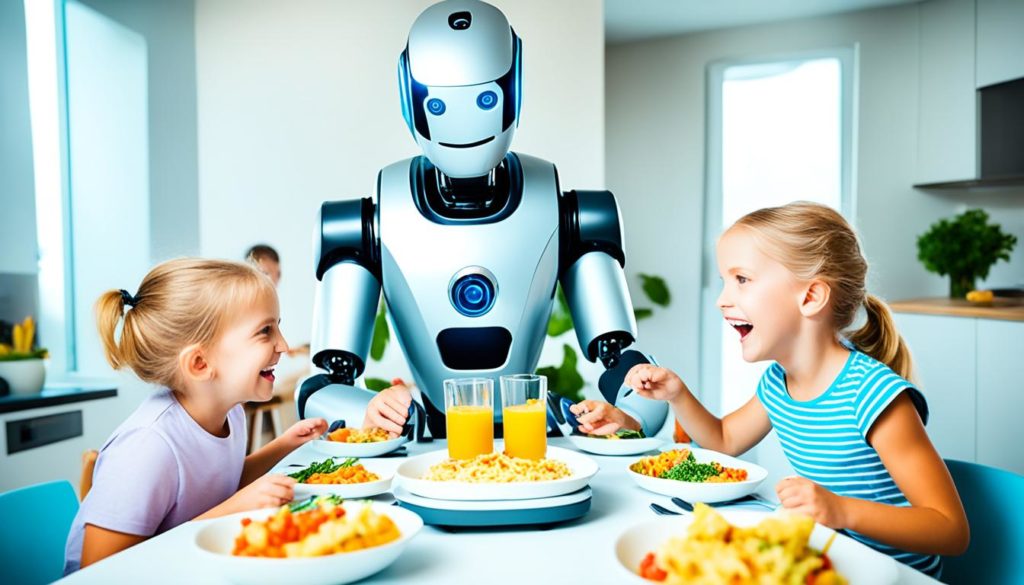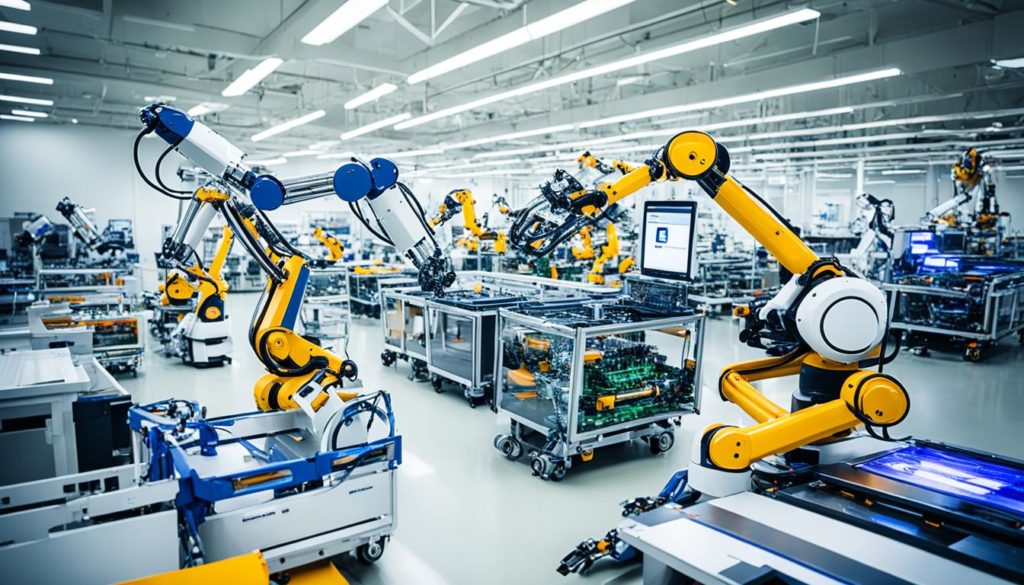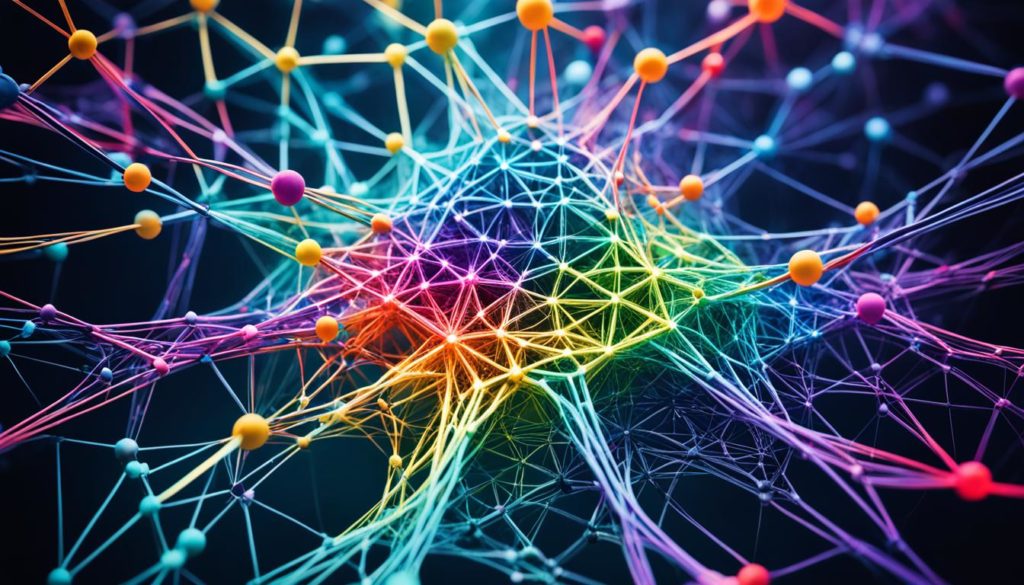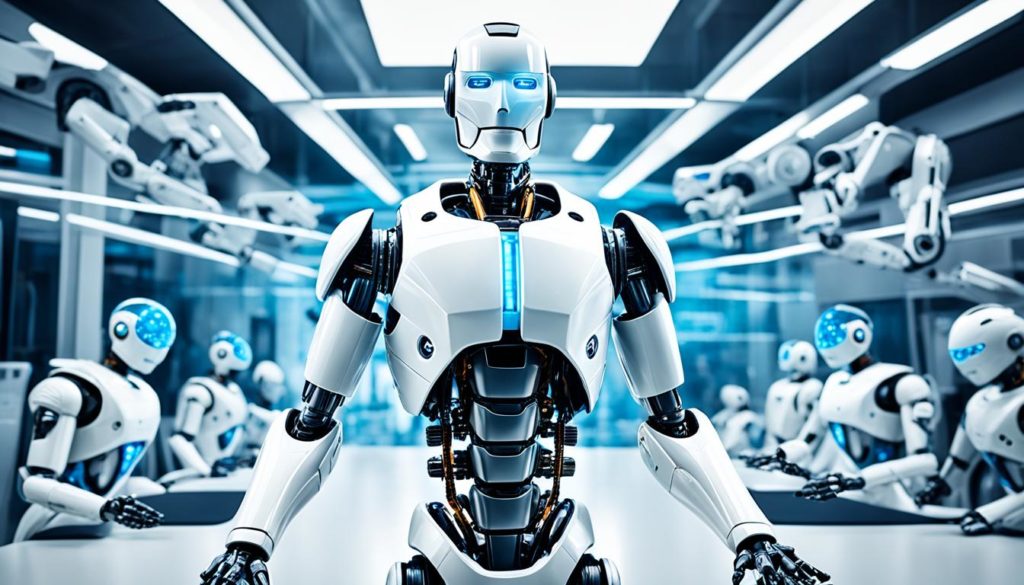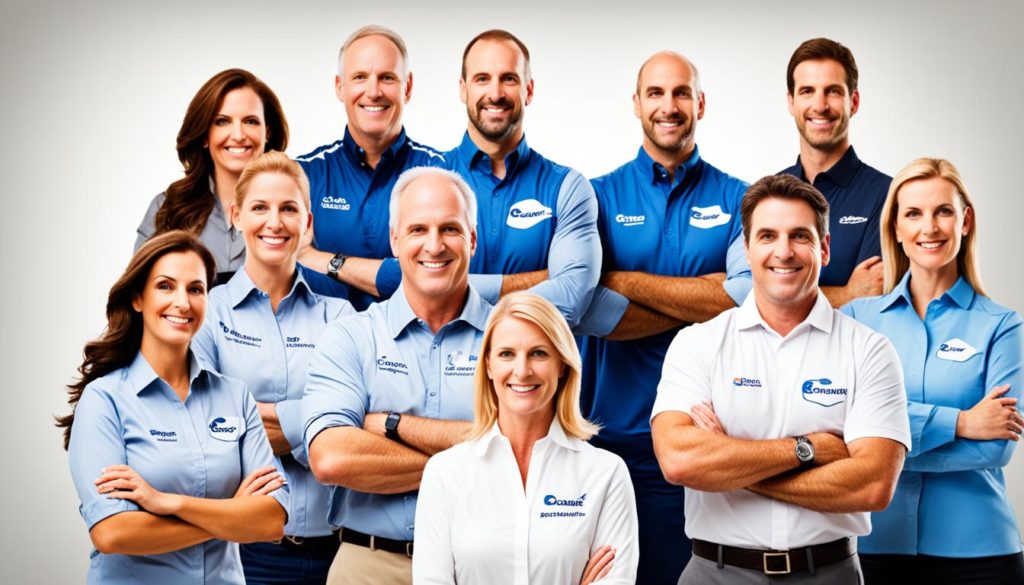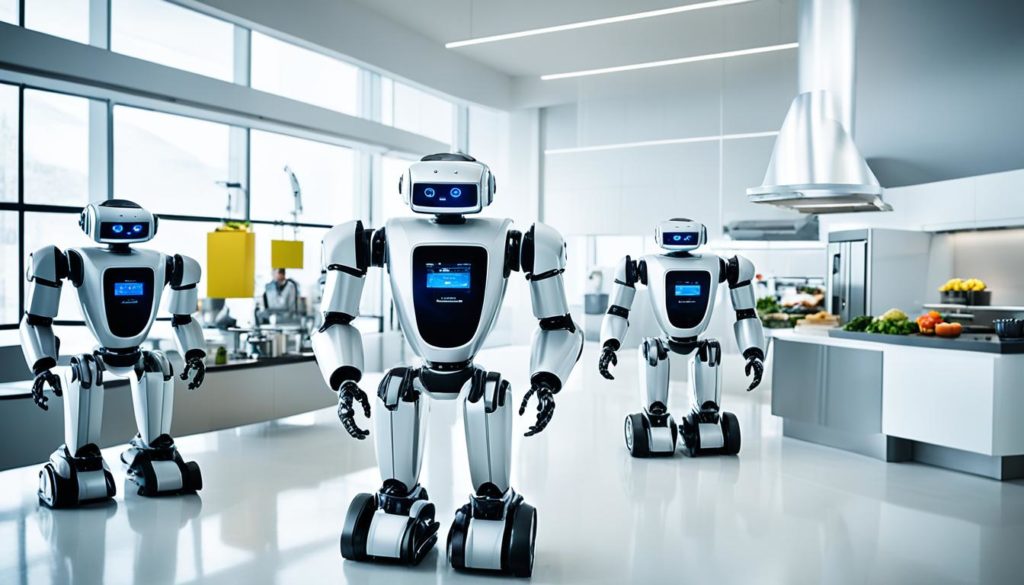
Imagine a world where 30% of jobs might be replaced by robots by 2030. That’s about 51 million jobs worldwide. This reveals how fast robots are becoming a part of our lives. We are seeing more AI and robots in everyday life. They are becoming part of our daily routines and making life better.
By 2025, robots could disrupt up to 85 million jobs around the world. This shows how important robots are becoming in work and life. We’re moving towards a time when factories and cars will run themselves, thanks to AI. Robots are not just future talk, but today’s reality.
Robots like EVE and Phoenix are being made to meet our needs. They can carry heavy items and work on their own for a long time. Thanks to technology like Google’s DeepMind’s RoboCat, robots can do many tasks with little training. They’re becoming an essential part of our homes, jobs, and public places.
The benefits of these advanced technologies are many. They can make us more efficient, simplify tasks, and even make us happier. For example, robots can help reduce loneliness in the elderly. This shows how robots can positively affect our health and happiness.
Robots are changing things in many areas, like travel and industry. In 2021, there were 518,000 new robots. This means robots are becoming a big part of what we talk about and do every day.
Key Takeaways
- By 2030, 30% of jobs could be replaced by robots, impacting 51 million roles worldwide.
- Fully autonomous manufacturing processes are projected by the 2030s.
- By 2025, 85 million jobs may be disrupted by machines.
- Robots like EVE and Phoenix are equipped with advanced capabilities for everyday tasks.
- Global robot installations reached a record high of 518,000 units in 2021.
- Self-driving cars are anticipated to be widely available by 2030.
- Social robots can reduce loneliness and improve the well-being of older adults.
For a deeper dive into how robots and AI are transforming lives, explore the rise of robots business.
Introduction to Robots in Everyday Life
Robots have changed a lot since being first mentioned in a 1921 science fiction play. Now, they’re a big part of our daily lives. We see the robotics impact on daily routines everywhere. Robots help with home tasks and even complex medical procedures.
Overview of Robotics
Robotics now touches many areas like manufacturing, services, and education. Thanks to advanced robotics, these machines are easier to use and more helpful. Robots that perform everyday tasks make our lives simpler. They work by using smart AI to fit into different settings easily.
Robots help with schoolwork and medical care. The role of robots in modern living is growing. They improve how well we live and work together.
What Are Robots?
Robots are machines that can do tasks on their own or with little help. They use sensors and controls to work without us telling them what to do every time. Though we think of robots in factories, they’re now part of many everyday activities. This shows how they influence our robotics impact on daily routines.
Types of Robots in Modern Living
Here are the main types of robots we see every day:
- Household Robots: They include vacuum cleaners like Roomba and kitchen helpers for cooking.
- Industrial Robots: Important in auto manufacturing, they do jobs from assembling to welding.
- Medical Robots: Used in checks and surgeries since 2007, and also for recovery and elder care.
- Educational Robots: They are used in schools to boost team work, creativity, and STEM skills.
- Companion Robots: These robots keep the elderly company, talk, remind, and entertain them.
Looking forward, robots’ role is only going to get bigger. They help us every day, add to different fields, and close the gap between humans and tech. For more on how robots fit into our lives, check out the use of robots in everyday.
Impact of Robotic Technology on Daily Routines
Robotic technology has changed our day-to-day life, making things faster and more accurate. These advancements help us do tasks better and improve our happiness.
Automation in Daily Tasks
Automation has greatly influenced our daily activities. Robots do everything from cleaning and lawn mowing to managing smart homes. Amazon Robotics, for example, has made warehouses 20% more efficient.
The BoniRob can improve farming tasks by up to 80%. This shows how vital robots have become. The McKinsey Global Institute says automation could replace up to 800 million jobs by 2030. This means we need to adapt to stay competitive.
Benefits of Robots in Daily Life
Robots save us from repetitive jobs, giving us more time for what we enjoy. In healthcare, robotic aids like the da Vinci Surgical System have improved over 7 million operations. The robot PARO helps reduce stress in the elderly.
Examples of Robots at Home
Robotic devices are now common in our homes. They clean and mow lawns with ease. Smart home assistants make our lives easier by fitting into our homes seamlessly. The growth in home robots shows we’re moving towards a more automated life.
The home automation field is always growing. With each new development, we see how essential these robots are. They make our lives better each day.
In conclusion, robotics have transformed our daily routines, showing us a future filled with efficiency. By adopting these technologies, we improve both our work and personal lives.
Artificial Intelligence in Society
Artificial intelligence (AI) is changing how we live, work, and connect. It’s making robots smarter, allowing them to do complex tasks. These robots can now learn and talk in ways that seem very human, thanks to AI.
AI is also making things better in public services. For example, it’s improving how quickly and correctly diseases are diagnosed. This means doctors can be more accurate with their treatments. In education, AI helps in creating lessons that fit each student’s own way of learning.
AI is also reshaping our digital world. Robots powered by AI in public places help people interact from afar. As AI gets better, we’ll see even more of these smart systems. They won’t just follow orders; they will predict and meet our needs before we even ask.
The future of AI in society is wide open. By weaving AI into our everyday lives more, we open doors to endless possibilities. Intelligent robotics could redefine what’s possible, bringing new solutions and big changes in many areas.
| Domain | AI Application | Impact |
|---|---|---|
| Healthcare | AI Diagnostics | Improved accuracy and efficiency in disease detection |
| Education | Personalized Learning | Customized education experiences for students |
| Public Services | Automated Assistance | Enhanced service delivery with reduced human error |
| Social Interactions | AI-driven Communication | Facilitated remote participation and enriched communication |
Robotics Applications Across Different Industries
Robotics applications are changing many industries, making work more precise and efficient. In agriculture, automated systems like drones are transforming how we farm. These technologies help manage resources better and keep an eye on crops. This new way of farming boosts production and reduces waste, making it greener.
In retail, robots have become key in managing inventory. They reduce mistakes and ensure accurate stock levels. These robots also improve shopping experiences by providing information and guiding customers. This hints at a future where stores might be fully automated.
Robots are also making a mark in the hospitality and entertainment worlds. Hotels use them for tasks like room service, greatly enhancing guests’ stays. In entertainment, robots create fun, interactive exhibits at theme parks. These experiences are unique and captivate visitors.
In environmental conservation, robotics plays a vital part too. Drones and robots help monitor wildlife and ecosystems. They also aid in reforestation. This tech gathers precise data and supports efforts to protect nature and wildlife diversity.
| Industry | Application | Benefits |
|---|---|---|
| Agriculture | Automated Systems | Optimized resource management, increased yield, reduced wastage |
| Retail | Inventory Management Robots | Efficient stock keeping, enhanced customer service, full automation potential |
| Hospitality | Service Robots | Improved guest experiences, efficient task performance |
| Entertainment | Interactive Exhibits | Unique visitor experiences, engaging interactive activities |
| Environmental Conservation | Drones and Autonomous Robots | Precise data collection, habitat monitoring, reforestation efforts |
The growth in robotics is significantly changing various fields. Robots help improve productivity and make processes sustainable. From farming to customer service in hotels, robots are showing their value. Their ability to do diverse tasks makes them crucial for future advancements and efficiency.
Challenges and Ethical Considerations
In the robotics field, we need to look at the challenges and ethical issues that come up. With robots becoming a part of many areas of life, we face a lot of important concerns.
Job Displacement Concerns
Job displacement is a big worry with robotics. As robots start doing jobs humans used to do, many wonder about what work will look like in the future. It’s essential to find ways to help people learn new skills and find new jobs.
Privacy and Security Issues
Making sure robots are safe and keep people’s information private is a big challenge. We need to work hard to make robotic systems secure. This means testing them well and creating rules to stop any wrong use or data leaks.
Ethical Use of Robotics
Using robots ethically is very important. As robot technology gets better, we have to make sure they are made and used in ways that fit our society’s values. Thinking carefully about ethics will help us use robots to improve life for everyone.
Conclusion
The world of robotics is both fascinating and complex. We see robots in our homes and in surgery rooms, making life easier. They not only help us daily but also have the potential to change lives through telemedicine and support for those with disabilities.
But, embracing robotics comes with its own set of challenges. A study from the University of Duisburg-Essen shows how robots might affect our kindness to others. At the same time, a McKinsey Global Institute report suggests robots could replace up to 800 million jobs by 2030. It’s crucial to think about the ethics of robotics and keep talking about how it changes our world. Programs by Amazon and Siemens show us how to use robotics in a good way.
The future with robotics looks promising, with humans and robots working together. Imagine homes managed by AI that’s both efficient and secure or robots that keep the elderly company. If we’re smart about adopting new tech, we can make sure robots improve everyone’s lives while overcoming obstacles. For more insights, take a look at this detailed analysis of robots’ impact on society.
FAQ
What are the major types of robots used in everyday life?
In our daily lives, we encounter various robots. These include vacuum cleaners and lawn mowers for house chores. We also see social robots that offer company or help customers, and educational robots that aid in learning. For health, there are robots that assist in medical care and rehabilitation.
How are robots integrated into daily routines?
Robots help us by doing automated tasks like cleaning, cooking, and organizing. Advanced AI lets them learn from our habits. Over time, they become even better at helping us.
What benefits do robots bring to our daily lives?
Robots bring many advantages. They save us time, make us more productive, and keep us safe. They support us emotionally and make healthcare better. Robots assist with home tasks, help those in need, and simplify complex jobs in various settings.
How does AI enhance robotic technology in society?
AI boosts robots’ abilities, giving them skills in language, learning, and making decisions. This lets robots interact with humans in a meaningful way. They can do tasks on their own and get better from their experiences.
What industries have seen significant robotics applications?
We see robots used a lot in manufacturing, healthcare, farming, retail, and entertainment. They help with accurate automation, managing resources, keeping inventory, doing medical tasks, and engaging customers.
Are there ethical considerations in the deployment of robots?
Absolutely. Ethical issues include dealing with job losses and ensuring privacy and security. It’s vital to have rules that protect human rights. These rules should also promote skills for new jobs and make sure robots are used ethically.
How can robots improve healthcare delivery?
Robots enhance healthcare by handling deliveries, monitoring patients, and performing surgeries. They also sterilize equipment. This reduces risks to humans and increases the accuracy and efficiency of medical services.
What are some examples of robots used in home environments?
At home, robots like the Roomba vacuum cleaner and cooking assistants make life easier. There are robotic lawn mowers and smart assistants like Amazon Echo or Google Nest too. They control home systems, making our lives more comfortable.
What are the concerns regarding job displacement due to robots?
A big worry about robots is losing jobs, as they can do work humans used to do. This makes it important to teach people new skills. They need these skills for the jobs that will come with more robots around.
What measures ensure the privacy and security of robotic systems?
To keep robotic systems safe, we use strong encryption and update systems regularly. It’s also important to check for weaknesses and have laws. These laws must make sure there is clear user consent and transparency about data use.
Future App Studios is an award-winning software development & outsourcing company. Our team of experts is ready to craft the solution your company needs.


